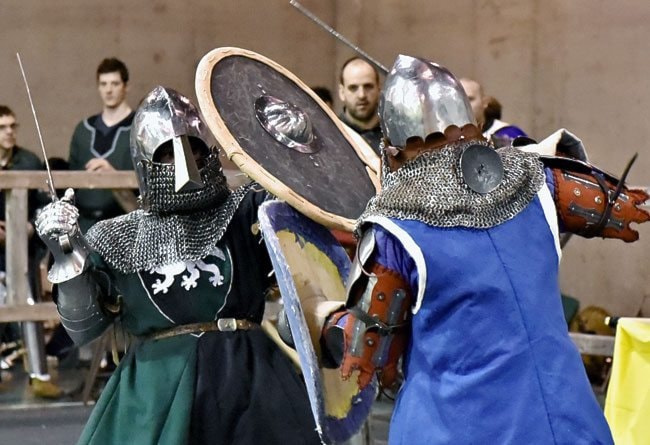Members of Yukon’s Company of the White Wolf chopped through the competition the weekend before last in Montreal.
Yukoners won a coffer of medals at the fifth annual Medieval Combat Arts Tournament, an event that saw teams from around the world compete in authentic pre-17th century European armour with real weapons (though the swords have blunted edges and dulled tips for obvious safety reasons).
It was the Company of the White Wolf’s first tournament outside the territory, “so it was really important for us to make a good showing,” said Whitehorse’s Land Pearson. “There were people there who represented Canada, went to an event called the Dynamo Cup, which is one of the hardest five-on-five competitions. Guys from that team were saying we brought a lot more skill and people than they expected.
We weren’t any slouches out there and they were really impressed by the quality of our armour as well.”
The Company of the White Wolf (CWW) was one of the larger teams at the event. They collected eight medals, including one gold.
In an instance of sibling rivalry gone medieval, Pearson defeated his older brother Lake for gold in the men’s sword and shield, in which both competitors are armed with a short one-handed sword and a shield.
Duelists score points by striking blows, disarming their adversary and knocking them down.
“Last summer we had our first tournament here (in Yukon) and he and I met in the finals there,” said Land, 32, who won that final as well. “I really think he’s technically a better fighter, but I seem to be able to take it from him when it counts.
“We’re developing a rivalry that’s going to grow more.”
With the loss to his brother in the final, Lake took the silver.
As champion, Land will likely be considered for the International Medieval Combat Federation’s world championship this May in Portugal.
“This was seen a bit as nationals and a place for people to be selected to represent Canada in Europe this year at world championships,” said Land.
“It sounds like my name will be put forward to have that opportunity. Canada hasn’t actually gone to world championships yet. Quebec has been attending for several years, but this will be the first time as
Canada going. So it’s kind of exciting and important to get our members onto that team – the first Canadian team.”
While Land pocketed the only gold for CWW, teammate Shauna L. Heasley fought to the most medals. Heasley won three bronze and a silver.
She took bronze in women’s polearm – a knife or axe blade fitted on a long pole – while teammate Nicole Grove won silver.
Heasley also claimed bronze in the women’s sword and shield, as well as the women’s longsword – a double-edged sword with a large handle for two-handed use.
Heasley and Grove also teamed up with a Quebec “mercenary” to win silver in the three-on-three duel.
CWW’s Cody Richards won silver in the men’s polearm, a couple spots ahead of teammate Don Hornby in fourth.
Yukon’s Steven Pearson just missed out on a medal, placing fourth in the men’s longsword.
The sport is super old but the CWW is relatively new. The CWW along with the sport’s governing body, the Yukon Medieval Combat Group (YMCG), stemmed from a presentation at the 2014 Yukomicon –
Yukon’s first comic book convention. At Yukomicon CWW captain Jose Martinez-Amoedo, who has represented Spain at the world championships, gave a presentation on the sport and it all snowballed from there.
“That’s where our club grew from,” said Land, who is president of the YMCG. “He gave his presentation and a few of us followed him around like puppies the rest of the day to hear more about it and it just sprang up from there.
“Most of us didn’t start getting armour until last summer. So it’s been around for a year and a half, but really only getting into armour the last six or eight months.”
A competitor’s armour can cost anywhere from $1,500 to $15,000. It’s the real McCoy, not a prop from Monty Python and the Holy Grail.
“Your armour and weapons do need to be authentic,” said Land. “When you go to a world championships, you’re allowed to have a time frame and then 25 years on either side for what your armour can all be.
You can’t be wearing a 10th century Viking helmet with 15th or 16th century renaissance armour. Anything that you’re wearing, you have to be able to give evidence it was true – proof from a manuscript or an effigy or something like that. You’re not allowed to show up with a Lord of the Rings helmet or anything.”
Contact Tom Patrick at
tomp@yukon-news.com
